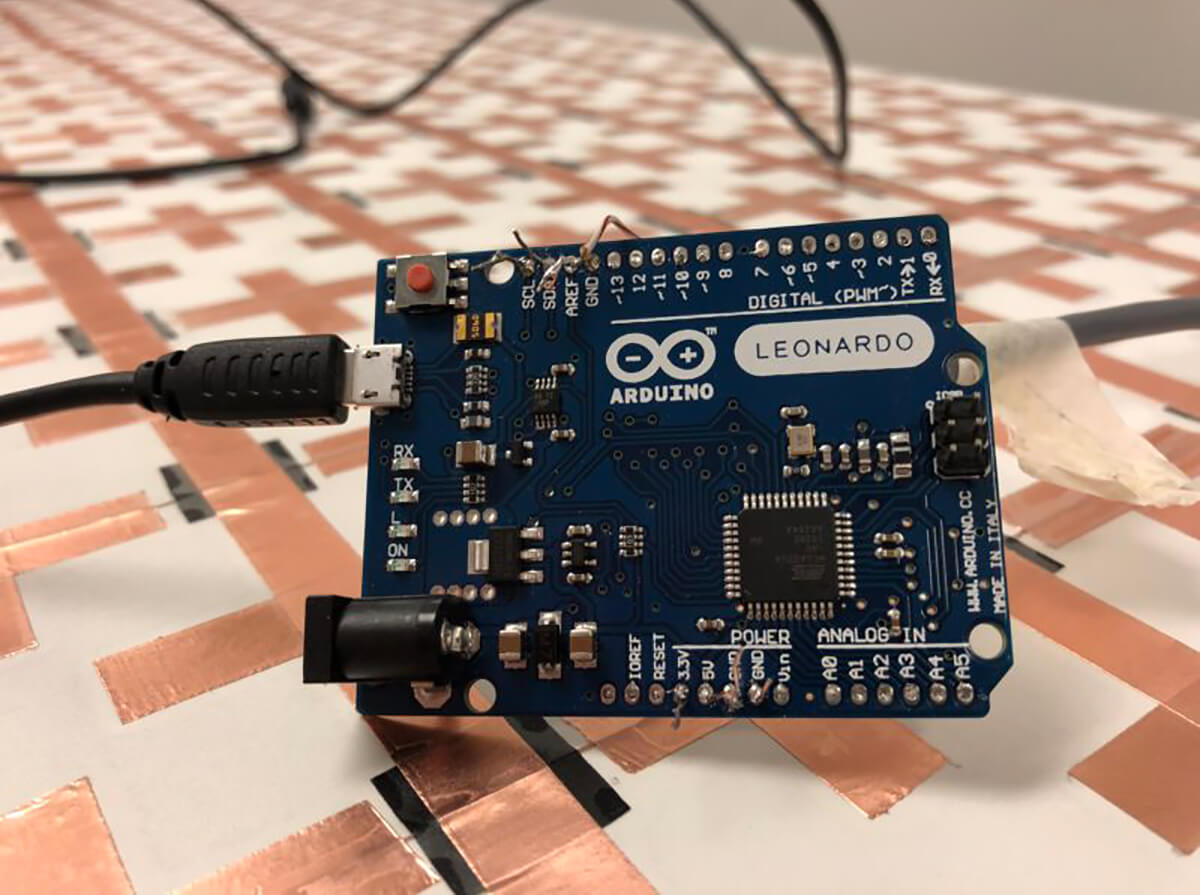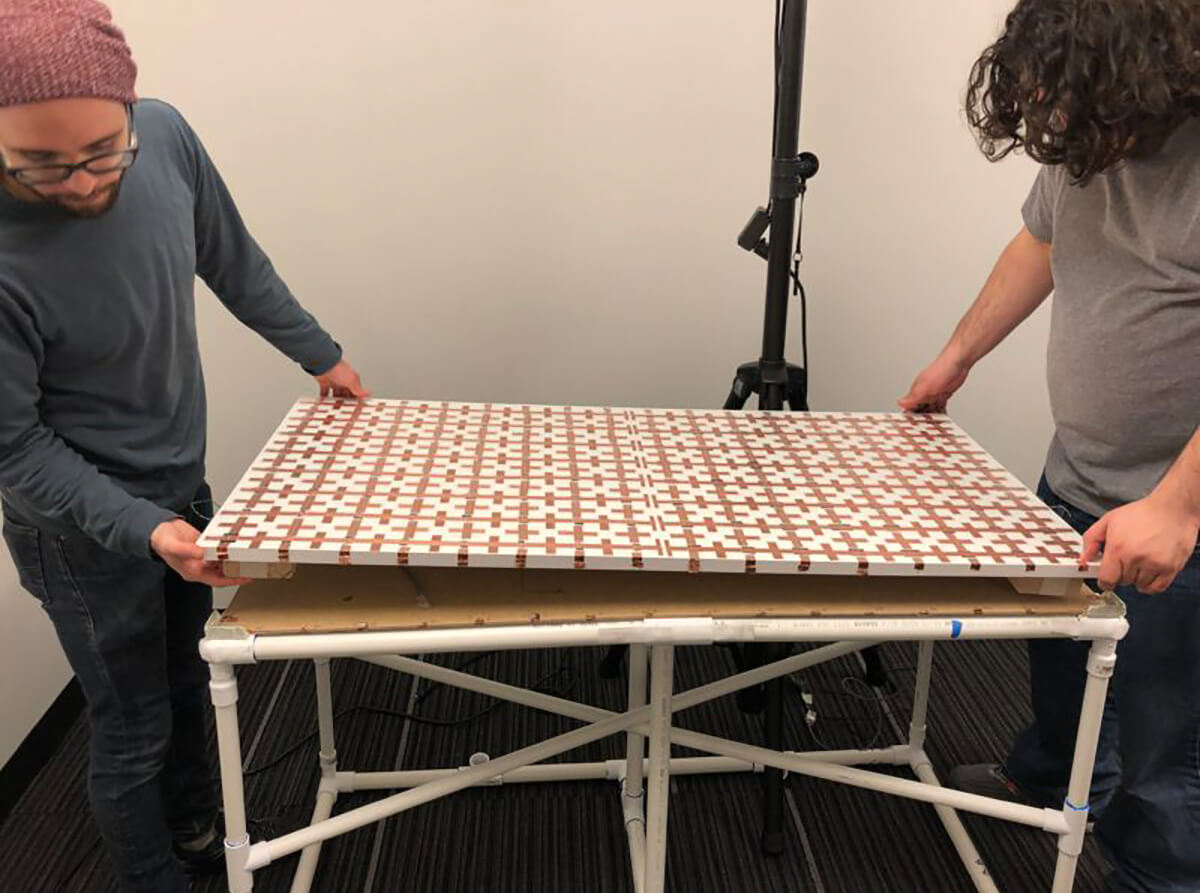For the second year in a row, a DigiPen student project has been chosen for the Game Developer Conference’s alt.ctrl.GDC, a showcase of “alternative control schemes and interactions in games.”
Last year, DigiPen’s Team Psylight made the trip from Redmond to San Francisco to show off their game Sand Garden, which utilized a physical three-foot-by-three-foot sand box monitored by an Xbox Kinect as its controller. This year, DigiPen team Guerrilla Nouveau will head down to show off their game Striker Air Hockey, a project that actually didn’t start out as a game at all.
“I was interested in taking digital art into the streets, like installations,” says Guerrilla Nouveau team lead, art director, and MFA in Digital Arts student Alex L. Bennett. “I wanted to design interactive art that could work as a pop-up — something not very expensive that was also lightweight enough that you could fit it in a car.”
That interest turned into the bulk of the work for Bennett’s thesis project, an interactive art installation titled Bee that would inadvertently become the seed for Striker Air Hockey. The piece explored the widespread phenomenon of colony collapse disorder — a mysterious sudden disappearing of worker bees that has the potential to severely impact Earth’s ecosystems — as well as larger themes like how technology, humanity, and nature relate to one another. Beyond the visual elements, Bennett also decided to bake those themes of interdependence into the physical experience of the installation.
“One of the things that was important to me was getting people together where they have to work together in order to get the piece to work,” Bennett says.
Bee’s technical innovation that enabled Bennett’s vision came from the combination of projection and capacitive touch technology, the latter being the same technology that’s used in touchscreens, albeit done here in a much more DIY fashion.
Guerilla Nouveau producer, interaction designer, programmer, and BA in Game Design student Jason Eldred led the charge on the tech end for Bee, despite the fact that he was a little out of his element at first. Eldred started from scratch with a device called the Makey Makey, a simple circuit board that can connect ordinary objects to computers. Once he familiarized himself with that, he went to an Arduino microcontroller workshop, where he got to program some simple tasks using LED lights. When the formal instruction portion of the workshop came to a close, there was still some time left, so Eldred asked the instructor if he could stick around to receive some help on a more complicated task: connecting an Arduino to a computer running the Unity game engine.

“By the end of the night,” Eldred says, “I had a little turn dial feeding into Unity changing the scale of a circle. That, for me, was this light switch moment, like, ‘Oh, if I can get this done in a night, what can I get done in a semester?’”
Combining the Makey Makey, the Arduino, Unity, a wooden board, and some scrappy capacitive touch buttons made from tin foil patches, Eldred birthed Bennett’s vision for Bee into existence.
Bee bent the typical relationship between art exhibitions and those experiencing it, turning “viewers” into something closer to players in a co-op game. The interactive installation was comprised of a board of touch buttons overlaid with dynamic projections that up to two users could manipulate at a time. The buttons triggered visuals and audio on a larger projection screen in front of them. Thanks to simple circuit detection techniques, the team built-in interactive features that required users to physically touch as well.
Kids would go up and touch it and a bunch of bees would shoot out on the projection and they’d go, ‘Oh my God, it explodes!’ and start hitting it as hard as they could.”
Bee proved incredibly popular when the team displayed it at the 2017 Seattle Mini Maker Faire. In some cases, the response was a little too enthusiastic. “Kids would go up and touch it and a bunch of bees would shoot out on the projection and they’d go, ‘Oh my God, it explodes!’ and start hitting it as hard as they could,” Eldred laughs, “So, you know, we adapted it to deal with that.”
Not only were kids enthralled; teachers were as well. “We were approached by a lot of people saying ‘Oh, could you bring this to our school? We need this at our school!’” Aldred says. “And we were like, ‘Uh, we’re not set up for that right now but that sounds cool!”
One woman at the Faire who had done museum design and display work at the Smithsonian in Washington D.C. and the Museum of Flight in Tukwila took particular interest in the project. “She was impressed because we were able to get all this projection and so much interactivity with such a shoestring budget,” Bennett says.
According to the team, the most expensive part of the setup was the projector and the lighting truss to hold it, roughly $600 together. The rest cost under $50.
From Swipes to Striker
Guerilla Nouveau’s next art project that would nudge them even closer to Striker Air Hockey came after the team observed a common interaction people were having with Bee.
“We saw that people kept wanting to do swipe motions like [on] a real touch screen,” Eldred says. “We were like, ‘We don’t have that functionality, but we want it too!’”
The team eventually recruited BS in Computer Science and Game Design student Gabe Miller to help develop Frames, a new digital art project using similar touch and projection technology that could be mounted on a wall via magnets.

To achieve the desired swipe functionality, Miller took the individual tin foil touch button idea from Bee and expanded it, creating a giant crisscrossing grid of copper tape and wires. “You can think of each of the strips as a single, very long capacitance touch button,” Miller says. “What we can do is just use the intersections of the capacitive touch readings on the grid to figure out where your hand is on the board.”
After months of trials and tribulations in the R&D process, the unexpected chief obstacle being static interference from the carpet, the team created a functioning prototype for their swipe-friendly Frames project.
“This started out as our prototype before we’d go on to a larger surface,” Bennett says. “But as we were working on the prototype, we went, ‘You know, this is actually working really well. What if we just threw a game on top of it and applied to GDC?”
While the hardware Striker Air Hockey is built on took semesters of work, the actual game took just one week to develop, with one additional week to add extra bells and whistles.
“It all happened really quickly,” Bennett says.
The two-player game is, as its title suggests, much like classic air hockey — the innovation being that you control your striker by simply moving your hand around the table on the projected surface. The game sports multiple play modes as well, including chaotic multi-puck play and tables with gravity-shifting wells.
“One of the reasons we did air hockey is that it’s a really palm-oriented game with large general motions, which works really well with this platform,” Miller says.
While the team is excited to go to alt.ctrl.GDC, they’re already dreaming of new applications for the platform, which the team has tentatively named Podium.
“This can fit under school and museum budgets,” Miller says. “If you don’t have the money for AR technology for a bunch of individuals, this is a great alternative, because all you need is room and someone to build it.”While the team’s vision for Frames has fallen a bit by the wayside since half of the team is graduating soon, Bennett’s ultimate vision for Podium is to open it up as a platform that anyone can develop for.
“We’d love for other people to create little games or interactions for something like a jam, maybe get DigiPen students or faculty to make something that could be showcased through this platform,” Bennett says. “Now, my main goal for this project is just opening this hardware up to be as accessible as possible.”
Striker Air Hockey was created by Alex Bennett, Jason Eldred, Gabe Miller, Andrew Margarella and Dustin Williams.
